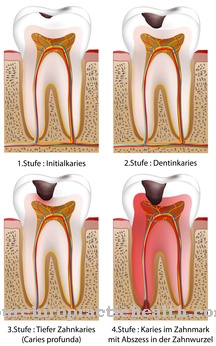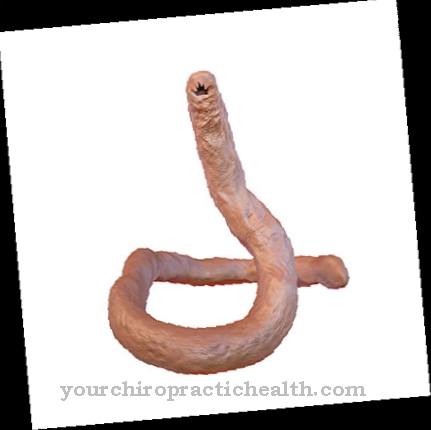At a Spidernavus it is a new formation of vessels on the skin. The disease is relatively common. The optical changes are usually clearly visible because the arterial vessels of the skin expand. It is also possible that the spider's nevus appears as a so-called hepatic sign in some of the affected patients. As such, it develops in the context of chronic diseases of the liver.
What is a spider nevus?

© SciePro - stock.adobe.com
Of the Spidernavus is synonymous by part of the doctors as well Spider nevus, Nevus araneus, Star nevus or Vascular spider designated. As part of the disease, new arterial vessels form on the skin, which in the majority of cases are benign. The starting point of the phenomenon is usually formed by raised nodes of vessels.
From these centers of new blood vessel formation, delicate runners branch out into the surrounding areas of the skin. This usually results in a pattern that appears star-shaped or is reminiscent of a spider web. The common disease term spidernavus is derived from this. If pressure is applied to the nevus, the thin extensions are temporarily not visible. The central vessel does not disappear, however, but always has a reddish color.
causes
The causes for the formation of a spider nevus are different, but in most cases it is a question of benign changes in the arterial vessels of the skin. In many patients, the spider nevus arises in the upper half of the body. The neck and face areas as well as the hands are particularly affected by the changes.
Spider nevus is often associated with telangiectasia and is an expression of this disease. In many cases, spider nevi develop in childhood and then usually have no identifiable cause. In some cases, the development of a spider nevus is related to an existing pregnancy. In addition, the changes in the skin vessels may also show up in patients who use hormonal contraception.
Occasionally, spider nevi are favored by excessive sun exposure, as a result of which the skin is chronically damaged. Some of the patients have serious causes for the development of a spider nevus. The skin changes develop partly as part of diseases of the liver. It is possible here, for example, that a spider's nevus is an accompanying symptom of liver cirrhosis.
Symptoms, ailments & signs
The appearance of a spider's nevus can be clearly distinguished from other changes on the skin. The phenomenon is primarily characterized by the cobweb-like pattern that it forms on the skin of the affected patient. As a rule, there is a central vessel, which is usually red in color.
Starting from this main vessel, numerous small runners wind their way into the surroundings. The ramifications become thinner as the distance from the central vessel increases. Basically, these are so-called telangiectasias of the capillary skin vessels. The further away they are from the main vessel, the more they fade.
In numerous cases, the spider nevi can be found in the neck, on the chest wall or in the face area. Here they appear mainly on the forehead. A spider nevus may be an expression of an underlying disease and in such a case may make it easier to diagnose.
For example, spider nevi develop in connection with Osler's disease, pregnancy or chronic hepatitis. In principle, spider nevi also occur in healthy people. Only in some cases does the spider nevus give an indication of the existence of a causative underlying disease.
Diagnosis & course of disease
The spider nevus is usually diagnosed relatively quickly and easily based on its typical appearance. Nevertheless, the diagnosis follows the standard procedure, so that an anamnesis takes place at the beginning. Here the respective patient describes their symptoms and possibly known factors relevant to the development. In addition, the sick person explains their lifestyle, which the doctor can possibly better classify the symptoms.
The physical exam consists of the attending physician examining the affected areas of the skin with a special magnifying glass. However, since the optics of the spider nevus do not reveal anything about its cause, further examinations are usually necessary to rule out or diagnose potential underlying diseases.
Complications
In most cases, those affected with the spidernavus suffer from skin discomfort. These complaints can lead to significantly reduced aesthetics for the patient. Inferiority complexes or a reduced self-esteem often occur, so that patients feel ashamed of the symptoms and feel uncomfortable with them. This can sometimes lead to depression or other mental disorders.
The symptoms can be very uncomfortable, especially in the face. However, the spider nevus does not have to indicate a different disease in every case. Nevertheless, if these symptoms occur, a medical examination should be carried out in order to avoid further complications. The treatment of this disease takes place without complications with the help of laser therapy. This means that skin complaints can be limited and treated relatively well.
However, if the spider nevus is triggered due to another underlying disease, this must usually also be treated. Most often with this disease there is no reduction in the patient's life expectancy. However, the symptoms can reappear after the treatment. Those affected are dependent on renewed treatment.
When should you go to the doctor?
A spider nevus should always be examined and treated by a doctor. Since this disease cannot heal itself, the person concerned is always dependent on treatment. This is the only way to prevent further complications. The earlier the doctor is consulted with a spider nevus, the better the further course of the disease is usually.
A doctor should be consulted if there are symptoms of the skin that do not go away on their own and persist over a longer period of time. This creates spider web-like patterns, which can significantly reduce the aesthetics of the person affected. In most cases, the spots do not cover the entire body, only individual areas. If these symptoms occur over a longer period of time, a doctor must be consulted in any case.
As a rule, a spider nevus can be treated by a dermatologist or a general practitioner. There are no particular complications and, as a rule, the disease progresses positively.
Treatment & Therapy
Apart from the possible underlying diseases that need urgent treatment, the spidernavus itself is primarily a cosmetic blemish. As such, it can be treated and eliminated using various methods. As a rule, laser therapy is the first choice to make the spider nevus fade or completely disappear. However, the search for the triggering factors should not be ignored.
A so-called depth laser is used in numerous cases as part of the removal of the spider nevus by means of laser treatment. The enlarged arterial skin vessels are heated strongly. As a result, the spider nevus increasingly fades, and several sessions may be necessary for complete elimination. The results satisfy the majority of patients.
You can find your medication here
➔ Medicines against redness and eczemaprevention
Prevention of spider nevus is fundamentally difficult because it occurs either idiopathically or as a result of a large number of underlying diseases. Targeted measures to prevent the formation of new arterial skin vessels are therefore practically impractical.
Aftercare
A spider naevus does not require any special aftercare. It is a harmless skin change that occurs as part of chronic liver disease. After a cosmetic procedure, the patient usually has to spend a few more days in the clinic. As soon as the surgical wound has healed, you can leave the hospital.
As part of the aftercare, mild pain relievers are sometimes prescribed. In addition, a conversation with the doctor takes place in which the further procedure is discussed. Several sessions may be necessary to completely remove the skin lesion. The actual aftercare usually only includes a final discussion with the doctor in which open questions from the patient are clarified. If a spider nevus develops again after the recovery, the doctor must be consulted in any case.
If necessary, a therapist can be called in to advise the patient further. Psychological support is particularly useful in the case of psychological complaints due to the skin changes. The doctor responsible can put you in touch with a suitable therapist. Follow-up care for spider nevus is carried out by the chief physician in the clinic or the internist who is already treating the liver disease. If the liver disease has cured, the family doctor can take care of the follow-up care.
You can do that yourself
The disease is accompanied by an optical flaw. For this reason, building and promoting self-confidence are particularly important. In everyday life, feelings of shame or fear should be overcome. If this does not succeed to a sufficient extent, therapeutic help must be sought.
Dealing openly with the disease and educating people from social life about the peculiarities of the skin help to reduce unpleasant looks or questions to a minimum. Often it is enough to wear certain items of clothing or accessories to adequately cover the affected parts of the body. The focus is on promoting well-being and joie de vivre. The changes in the complexion of the skin should not determine the entire life. Mental stability is particularly important in order to avoid secondary psychological disorders. Even though negative thoughts arise, care should be taken to avoid brooding or other mentally stressful situations.
To avoid complications or deterioration of the skin's appearance, cosmetic items should only be used in consultation with the treating doctor. The ingredients and active ingredients must be checked for the needs of the organism before use. Should there be unpleasant situations or insults in everyday life, these should be discussed with other people.












.jpg)



.jpg)










.jpg)
